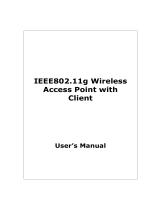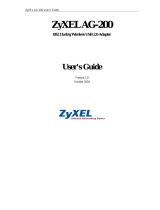
Table of Contents
NWD-271N User’s Guide
7
Table of Contents
About This User's Guide..........................................................................................................3
Document Conventions............................................................................................................4
Safety Warnings........................................................................................................................6
Table of Contents......................................................................................................................7
Chapter 1
Getting Started..........................................................................................................................9
1.1 Overview ................................................................................................................................ 9
1.1.1 What You Need to Know .............................................................................................. 9
1.1.2 Before You Begin .........................................................................................................9
1.2 Features .............................................................................................................................. 10
1.3 Hardware Installation ............................................................................................................11
1.4 Software Installation .............................................................................................................11
1.4.1 Minimum System Requirements .................................................................................11
1.4.2 Installing the ZyXEL Utility ......................................................................................... 12
1.5 Device Applications ............................................................................................................. 15
Chapter 2
Wireless LANs.........................................................................................................................17
2.1 Overview .............................................................................................................................. 17
2.1.1 What You Can Do in This Section .............................................................................. 17
2.1.2 What You Need to Know ............................................................................................ 17
2.1.3 Before You Begin ....................................................................................................... 18
2.2 Wireless LAN Overview ...................................................................................................... 18
2.3 Wireless LAN Security ........................................................................................................ 19
2.3.1 User Authentication and Encryption ........................................................................... 19
Chapter 3
Tutorial.....................................................................................................................................21
3.1 Connecting to a Wireless LAN ............................................................................................. 21
Chapter 4
ZyXEL Utility............................................................................................................................23
4.1 Overview .............................................................................................................................. 23
4.1.1 What You Need to Know ............................................................................................ 23
4.1.2 Before You Begin ....................................................................................................... 23























